In Situ Monazite U–Pb Ages in Thin Sections from the Giant Bayan Obo Fe–REE–Nb Deposit, Inner Mongolia: Implications for Formation Sequences
Abstract
:1. Introduction
2. Geological Setting
Ore Geology
3. Samples

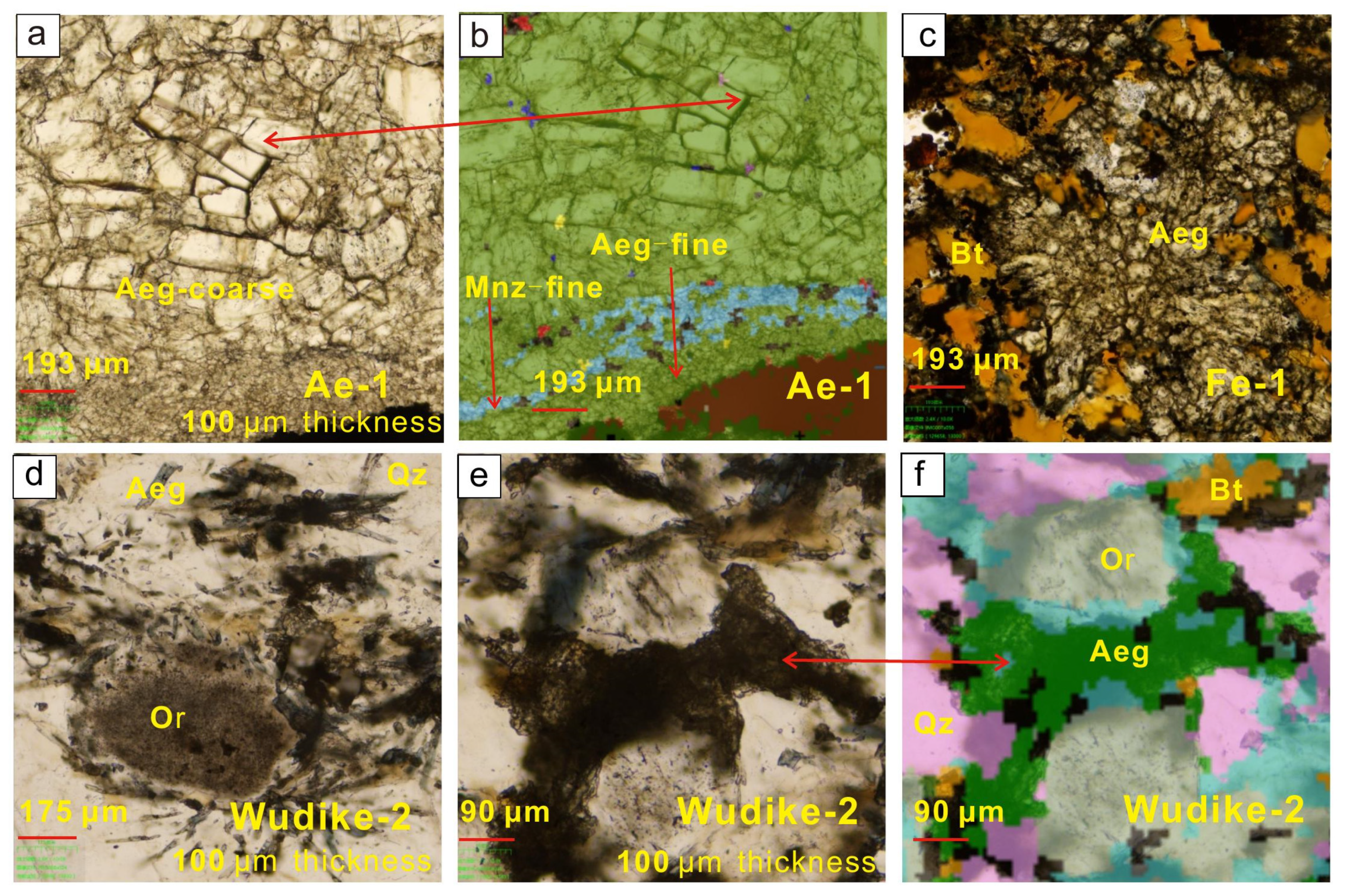
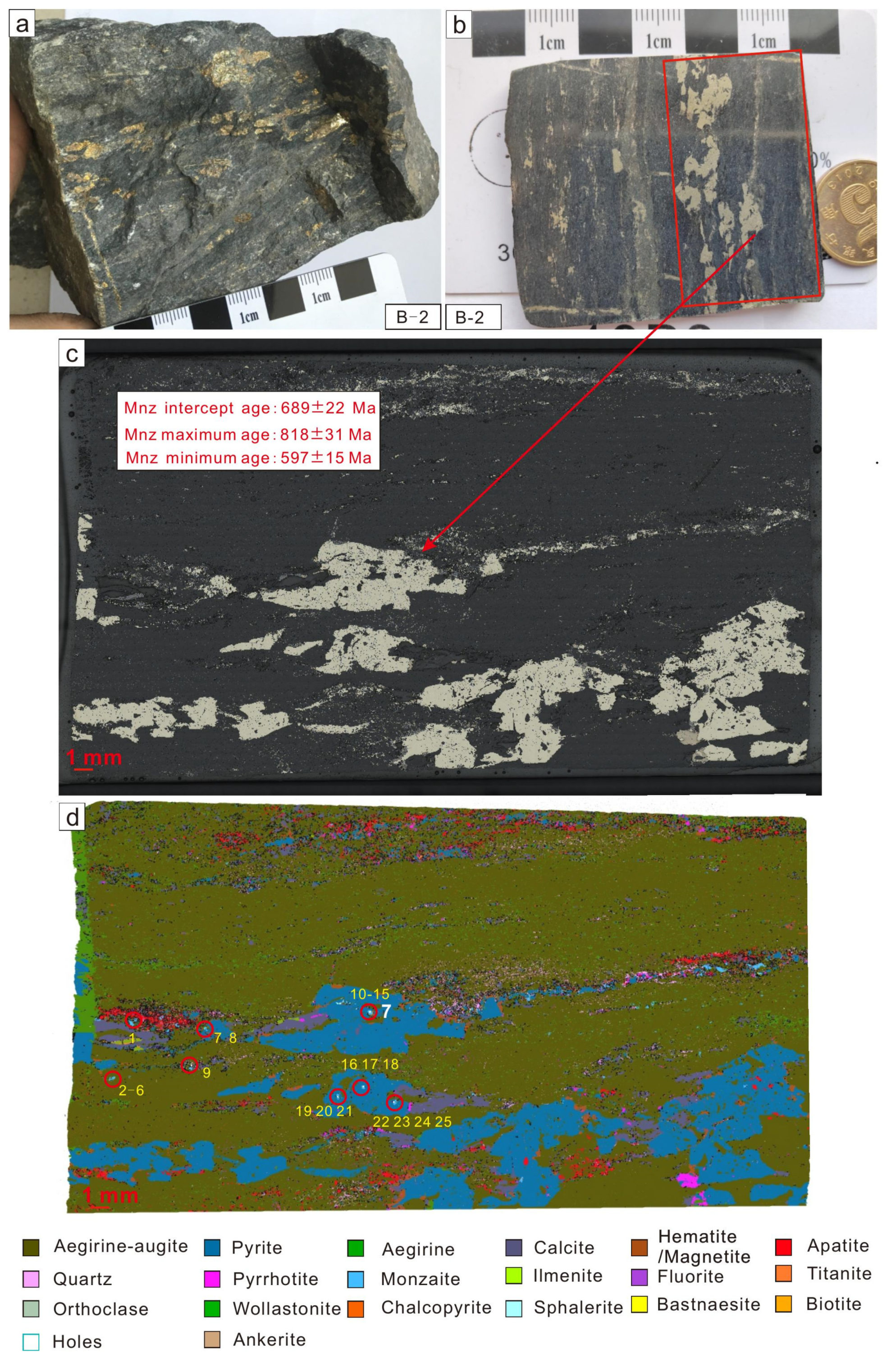
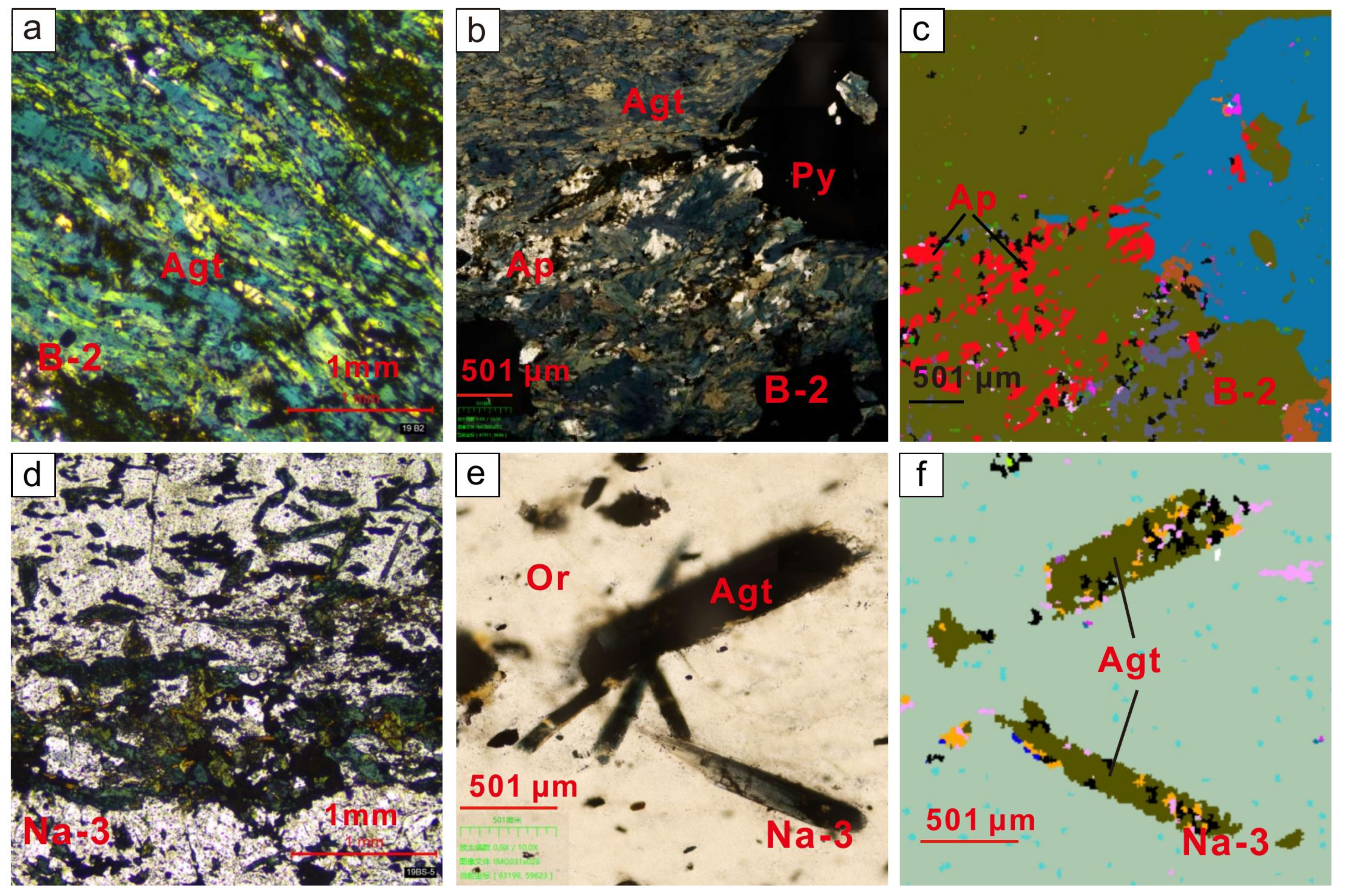
4. Analytical Methods
4.1. Microscope Full Scan
4.2. TIMA Method
4.3. Monazite U–Pb Dating
5. Results
Monazite Ages
6. Discussion
6.1. Basement Ages
6.2. Dike Ages
6.3. Carbonatite Ages
6.4. Granite Ages
6.5. Slate Ages
6.6. Ore Body Ages
6.6.1. Re–Os, Rb–Sr, and Ar–Ar Ages
6.6.2. Th–Pb Ages
6.6.3. U–Pb Ages
6.6.4. Sm–Nd Ages
6.7. The Age Sequence
6.7.1. ~2.5 Ga
6.7.2. ~1.9 Ga
6.7.3. ~1.4–1.3 Ga
6.7.4. ~1.1–0.4 Ga
6.7.5. ~0.3–0.2 Ga
7. Conclusions
Author Contributions
Funding
Data Availability Statement
Acknowledgments
Conflicts of Interest
References
- Yang, K.F.; Fan, H.R.; Pirajno, F.; Li, X.C. The Bayan Obo (China) giant REE accumulation conundrum elucidated by intense magmatic differentiation of carbonatite. Geology 2019, 47, 1198–1202. [Google Scholar] [CrossRef]
- Yang, X.Y.; Lai, X.D.; Pirajno, F.; Liu, Y.; Ling, M.X.; Sun, W.D. Genesis of the Bayan Obo Fe-REE-Nb formation in Inner Mongolia, North China Craton: A perspective review. Precambrian Res. 2017, 288, 39–71. [Google Scholar] [CrossRef]
- Fan, H.R.; Hu, F.F.; Yang, K.F.; Pirajno, F.; Liu, X.; Wang, K.Y. Integrated U–Pb and Sm–Nd geochronology for a REE-rich carbonatite dyke at the giant Bayan Obo REE deposit, Northern China. Ore Geol. Rev. 2014, 63, 510–519. [Google Scholar] [CrossRef]
- Tian, P.F.; Yang, X.Y.; Yuan, W.M. Formation and preservation of the Bayan Obo Fe-REE-Nb deposit, Inner Mongolia: Insights from evidences of petrogenesis, geochemistry and apatite fission track dating. Solid Earth Sci. 2021, 6, 228–245. [Google Scholar] [CrossRef]
- Zhu, X.K.; Sun, J.; Pan, C.X. Sm–Nd isotopic constraints on rare-earth mineralization in the Bayan Obo ore deposit, Inner Mongolia, China. Ore Geol. Rev. 2015, 64, 543–553. [Google Scholar] [CrossRef]
- Song, W.L.; Xu, C.; Smith, M.P.; Chakhmouradian, A.R.; Brenna, M.; Kynický, J.; Chen, W.; Yang, Y.H.; Deng, M.; Tang, H.Y. Genesis of the world’s largest rare earth element deposit, Bayan Obo, China: Protracted mineralization evolution over ~1 b.y. Geology 2018, 46, 323–326. [Google Scholar] [CrossRef]
- Chen, W.; Liu, H.Y.; Lu, J.; Jiang, S.Y.; Simonetti, A.; Xu, C.; Zhang, W. The formation of the ore-bearing dolomite marble from the giant Bayan Obo REE-Nb-Fe deposit, Inner Mongolia: Insights from micron-scale geochemical data. Miner. Depos. 2019, 55, 131–146. [Google Scholar] [CrossRef]
- Li, X.C.; Yang, K.F.; Spandler, C.; Fan, H.R.; Zhou, M.F.; Hao, J.L.; Yang, Y.H. The effect of fluid-aided modification on the Sm-Nd and Th-Pb geochronology of monazite and bastnäsite: Implication for resolving complex isotopic age data in REE ore systems. Geochim. Cosmochim. Acta 2021, 300, 1–24. [Google Scholar] [CrossRef]
- Li, H.T.; Yang, K.F.; Gao, Y.P.; Zhao, J.; Yuan, X.Y.; Li, X.C.; Fan, H.R. Age and origin of the H9 member from the Bayan Obo Group: Implications for the genesis of the giant Bayan Obo Fe-Nb-REE deposit, China. Ore Geol. Rev. 2022, 146, 104927. [Google Scholar] [CrossRef]
- She, H.D.; Fan, H.R.; Yang, K.F.; Liu, X.; Li, X.H.; Dai, Z.H. Carbonatitic footprints in the Bayan Obo REEs deposit as seen from pyrite geochemistry. Precambrian Res. 2022, 379, 106801. [Google Scholar] [CrossRef]
- Wei, C.W.; Deng, M.; Xu, C.; Chakhmouradian, A.R.; Smith, M.P.; Kynicky, J.; Song, W.L.; Chen, W.; Fu, B. Mineralization of the Bayan Obo Rare Earth Element Deposit by Recrystallization and Decarbonation. Econ. Geol. 2022, 117, 1327–1338. [Google Scholar] [CrossRef]
- Tang, H.; Liu, Y.; Song, W. Igneous genesis of the Bayan Obo REE–Nb–Fe deposit: New petrographical and structural evidence from the H1–H9 cross-section and deep-drilling exploration. Ore Geol. Rev. 2021, 138, 104397. [Google Scholar] [CrossRef]
- Fan, H.R.; Yang, K.F.; Hu, F.F.; Liu, S.; Wang, K.Y. The giant Bayan Obo REE-Nb-Fe deposit, China: Controversy and ore genesis. Geosci. Front. 2016, 7, 335–344. [Google Scholar] [CrossRef]
- Smith, M.P.; Campbell, L.S.; Kynicky, J. A review of the genesis of the world class Bayan Obo Fe–REE–Nb deposits, Inner Mongolia, China: Multistage processes and outstanding questions. Ore Geol. Rev. 2015, 64, 459–476. [Google Scholar] [CrossRef]
- Chew, D.; Spikings, R. Geochronology and Thermochronology Using Apatite: Time and Temperature, Lower Crust to Surface. Elements 2015, 11, 189–194. [Google Scholar] [CrossRef]
- Danišík, M. Integration of fission-track thermochronology with other geochronologic methods on single crystals. In Fission-Track Thermochronology and Its Application to Geology; Springer International Publishing: Cham, Switzerland, 2019; pp. 93–108. Available online: https://www.springer.com/series/15201 (accessed on 25 September 2022).
- Liu, Y.L.; Chen, J.F.; Li, H.M.; Qian, H.; Xiao, G.W.; Zhang, T.R. Single-grain U-Th-Pb-Sm-Nd dating of monazite from dolomite type ore of the Bayan Obo, deposit. Acta Petrol. Sin. 2005, 21, 881–888. (In Chinese) [Google Scholar]
- Smith, H.A.; Giletti, B.J. Lead diffusion in monazite. Geochim. Cosmochim. Acta 1997, 61, 1047–1055. [Google Scholar] [CrossRef]
- Cherniak, D.; Watson, E.B.; Grove, M.; Harrison, T.M. Pb diffusion in monazite: A combined RBS/SIMS study. Geochim. Cosmochim. Acta 2004, 68, 829–840. [Google Scholar] [CrossRef]
- Wawrzenitz, N.; Krohe, A.; Rhede, D.; Romer, R.L. Dating rock deformation with monazite: The impact of dissolution precipitation creep. Lithos 2012, 134, 52–74. [Google Scholar] [CrossRef]
- Lai, X.D.; Yang, X.Y.; Santosh, M.; Liu, Y.L.; Ling, M.X. New data of the Bayan Obo Fe–REE–Nb deposit, Inner Mongolia: Implications for ore genesis. Precambrian Res. 2015, 263, 108–122. [Google Scholar] [CrossRef]
- Ren, Y.S.; Yang, X.Y.; Wang, S.S.; Öztürk, H. Mineralogical and geochemical study of apatite and dolomite from the Bayan Obo giant Fe-REE-Nb deposit in Inner Mongolia: New evidences for genesis. Ore Geol. Rev. 2019, 109, 381–406. [Google Scholar] [CrossRef]
- Santosh, M. Assembling North China Craton within the Columbia supercontinent: The role of double-sided subduction. Precambrian Res. 2010, 178, 149–167. [Google Scholar] [CrossRef]
- IGCAS. Geochemistry of the Bayan Obo Deposit; Science Press: Beijing, China, 1988. (In Chinese) [Google Scholar]
- Ling, M.X.; Zhang, H.; Li, H.; Liu, Y.L.; Liu, J.; Li, L.Q.; Li, C.Y.; Yang, X.Y.; Sun, W.D. The Permian–Triassic granitoids in Bayan Obo, North China Craton: A geochemical and geochronological study. Lithos 2014, 190–191, 430–439. [Google Scholar] [CrossRef]
- Kusky, T.; Li, J.; Santosh, M. The Paleoproterozoic North Hebei orogen: North China craton’s collisional suture with the Columbia supercontinent. Gondwana Res. 2007, 12, 4–28. [Google Scholar] [CrossRef]
- Zhong, Y.; Zhai, M.; Peng, P.; Santosh, M.; Ma, X. Detrital zircon U–Pb dating and whole-rock geochemistry from the clastic rocks in the northern marginal basin of the North China Craton: Constraints on depositional age and provenance of the Bayan Obo Group. Precambrian Res. 2015, 258, 133–145. [Google Scholar] [CrossRef]
- Liu, Y.F.; Bagas, L.; Nie, F.J.; Jiang, S.H.; Li, C. Re–Os system of black schist from the Mesoproterozoic Bayan Obo Group, Central Inner Mongolia, China and its geological implications. Lithos 2016, 261, 296–306. [Google Scholar] [CrossRef]
- Ning, S.Y.; Wang, F.Y.; Xue, W.D.; Zhou, T.F. Geochemistry of the Baoshan pluton in the Tongling region of the Lower Yangtze River Belt. Geochimica 2017, 46, 397–412. [Google Scholar]
- Wang, F.Y.; Ge, G.; Ning, S.Y.; Nie, L.Q.; Zhong, G.X.; White, N.C. A new approach to LA-ICP-MS mapping and application in geology. Acta Petrol. Sin. 2017, 33, 3422–3436. (In Chinese) [Google Scholar]
- Gonçalves, G.O.; Lana, C.; Scholz, R.; Buick, I.S.; Gerdes, A.; Kamo, S.L.; Corfu, F.; Marinho, M.M.; Chaves, A.O.; Valeriano, C. An assessment of monazite from the Itambé pegmatite district for use as U–Pb isotope reference material for microanalysis and implications for the origin of the “Moacyr” monazite. Chem. Geol. 2016, 424, 30–50. [Google Scholar] [CrossRef]
- Ling, X.X.; Huyskens, M.H.; Li, Q.L.; Yin, Q.Z.; Werner, R.; Liu, Y.; Tang, G.Q.; Yang, Y.N.; Li, X.H. Monazite RW-1: A homogenous natural reference material for SIMS U–Pb and Th–Pb isotopic analysis. Mineral. Petrol. 2017, 111, 163–172. [Google Scholar] [CrossRef]
- Ludwig, K.R. Isoplot 3.00: A Geochronological Toolkit for Microsoft Excel; No. 4; Berkeley Geochronology Center Special Publication: Berkeley, CA, USA, 2003; 74p. [Google Scholar]
- Zhang, Z.Q.; Yuan, Z.X.; Tang, S.H.; Bai, G.; Wang, J.H. Age and Geochemistry of the Bayan Obo Ore Deposit; Geological Publishing House: Beijing, China, 2003. (In Chinese) [Google Scholar]
- Fan, H.R.; Yang, K.F.; Hu, F.F.; Wang, K.Y.; Zhai, M.G. Zircon geochronology of basement rocks from the Bayan Obo area, Inner Mongolia, and tectonic implications. Acta Petrol. Sin. 2010, 26, 1342–1350. (In Chinese) [Google Scholar]
- Wang, K.Y.; Fan, H.R.; Xie, Y.H.; Li, H.M. Zircon U-Pb dating of basement gneisses in the super-large Bayan Obo REE-Fe-Nb deposit, Inner Mongolia. Chin. Sci. Bull. 2002, 47, 245–248. (In Chinese) [Google Scholar]
- Liu, Y.L.; Ling, M.X.; Williams, I.S.; Yang, X.Y.; Wang, C.Y.; Sun, W.D. The formation of the giant Bayan Obo REE-Nb-Fe deposit, North China, Mesoproterozoic carbonatite and overprinted Paleozoic dolomitization. Ore Geol. Rev. 2018, 92, 73–83. [Google Scholar] [CrossRef]
- Fan, H.R.; Chen, F.K.; Wang, K.Y.; Xie, Y.H.; Wilde, S.; Stair, M. Zircon U-Pb age of a carbonatite dyke from Bayan Obo REE-Fe-Nb deposit, Inner Mongolia and its geological, significance. Acta Petrol. Sin. 2002, 18, 363–368. (In Chinese) [Google Scholar]
- Lai, X.D.; Yang, X.Y. U-Pb Ages and Hf Isotope of Zircons from a Carbonatite Dyke in the Bayan Obo Fe-REE Deposit in Inner Mongolia: Its Geological Significance. Acta Geol. Sin. 2019, 93, 1783–1796. [Google Scholar] [CrossRef]
- Liu, Y.L.; Williams, I.S.; Chen, J.F.; Wan, Y.S.; Sun, W.D. The significance of Paleoproterozoic zircon in carbonatite dikes associated with the Bayan Obo REE-Nb-Fe deposit. Am. J. Sci. 2008, 308, 379–397. [Google Scholar] [CrossRef]
- Fan, H.R.; Hu, F.F.; Chen, F.K.; Yang, K.F.; Wang, K.Y. Intrusive age of No. 1 carbonatite dyke from Bayan Obo REE-Nb-Fe deposit, Inner Mongolia: With answers to comment of Dr. Le Bas. Acta Petrol. Sin. 2006, 22, 519–520. (In Chinese) [Google Scholar]
- Liu, Y.L.; Chen, J.F.; Li, H.M.; Xiao, G.W.; Zhang, T.R. Geochronology of the carbonatite dykes in the Bayan Obo orefield. Revisit. Geol. Rev. 2006, 52, 415–422. [Google Scholar]
- Ni, P.; Zhou, J.; Chi, Z.; Pan, J.Y.; Li, S.N.; Ding, J.Y.; Han, L. Carbonatite dyke and related REE mineralization in the Bayan Obo REE ore field, North China: Evidence from geochemistry, CO isotopes and RbSr dating. J. Geochem. Explor. 2020, 215, 106560. [Google Scholar] [CrossRef]
- Yang, K.F.; Fan, H.R.; Santosh, M.; Hu, F.F.; Wang, K.Y. Mesoproterozoic carbonatitic magmatism in the Bayan Obo deposit, Inner Mongolia, North China: Constraints for the mechanism of super accumulation of rare earth elements. Ore Geol. Rev. 2011, 40, 122–131. [Google Scholar] [CrossRef]
- Wang, J.; Cheng, Z.; Gui, X. Rb-Sr isotopic characteristics of granitic rocks from Bayan Obo, Nei Mongol, China. Ann. Rep. 1982-I 983 Inst. Geochem. Acad. Sin. 1983. [Google Scholar]
- Ling, M.X.; Liu, Y.L.; Williams, I.S.; Teng, F.Z.; Yang, X.Y.; Ding, X.; Wei, G.J.; Xie, L.H.; Deng, W.F.; Sun, W.D. Formation of the world’s largest REE deposit through protracted fluxing of carbonatite by subduction-derived fluids. Sci. Rep. 2013, 3, 1776. [Google Scholar] [CrossRef]
- Fan, H.R.; Hu, F.F.; Yang, K.F.; Wang, K.Y.; Liu, Y.S. Geochronology framework of late Paleozoic dioritic-granitic plutons in the Bayan Obo area, Inner Mongolia, and tectonic significance. Acta Petrol. Sin. 2009, 25, 2933–2938. (In Chinese) [Google Scholar]
- Zhang, Z.Q.; Tang, S.S.; Chen, Q.T.; Wang, J.H. Sm-Nd Ages and Origins of Metamorphic Rocks for the H9 Formation in the Bayan Obo Ore District, and Relationship with the Ore Forming Event. Acta Geosci. Sin. 1997, 18, 267–274. (In Chinese) [Google Scholar]
- Khain, E.V.; Bibikova, E.V.; Salnikova, E.B.; Kröner, A.; Gibsher, A.S.; Didenko, A.N.; Degtyarev, K.E.; Fedotova, A.A. The Palaeo-Asian ocean in the Neoproterozoic and early Palaeozoic: New geochronologic data and palaeotectonic reconstructions. Precambrian Res. 2003, 122, 329–358. [Google Scholar] [CrossRef]
- Hu, F.F.; Fan, H.R.; Liu, S.; Yang, K.F.; Chen, F.K. Samarium–Neodymium and Rubidium–Strontium Isotopic Dating of Veined REE Mineralization for the Bayan Obo REE-Nb-Fe Deposit, Northern China. Resour. Geol. 2009, 59, 407–414. [Google Scholar] [CrossRef]
- Zhang, Z.Q.; Tang, S.H.; Wang, J.H.; Yuang, Z.X.; Bai, G. Information about ore deposit formation in different epochs: Age of the west orebodies of the Bayan Obo deposit with a discussion. Geol. China 2003, 30, 130–137. (In Chinese) [Google Scholar]
- Liu, Y.L.; Yang, G.; Chen, J.F.; Du, A.D.; Xie, Z. Re-Os dating of pyrite from Giant Bayan Obo REE-Nb-Fe deposit. Chin. Sci. Bull. 2004, 49, 2627–2631. [Google Scholar] [CrossRef]
- Liu, L.S. The Re-Os isotopic age of molybdenite from Bayan Obo REE ore deposit. Min. Depos. 1996, 15, 188–191. (In Chinese) [Google Scholar]
- Ren, Y.C.; Zhang, Y.C.; Zhang, Z.Q. Study on heat events of ore-forming Bayan Obo deposit. Acta Geosci. Sin. 1994, 1–2, 95–101. (In Chinese) [Google Scholar]
- Wang, J.; Tatsumoto, M.; Li, X.; Premo, W.R.; Chao, E.C.T. A precise 232Th-208Pb chronology of fine-grained monazite: Age of the Bayan Obo REE-Fe-Nb ore deposit, China. Geochim. Cosmochim. Acta 1994, 58, 3155–3169. [Google Scholar] [CrossRef]
- Chao, E.C.T.; Back, J.M.; Minkin, J.A.; Tatsumoto, M.; Junwen, W.; Conrad, I.E.; McKee, E.H.; Zonglin, H.; Qingrun, M.; Shengguang, H. The Sedimentary Carbonate-Hosted Giant Bayan Obo REE-Fe-Nb Ore Deposit of Inner Mongolia, China: A Cornerstone Example for Giant Polymetallic Ore Deposits of Hydrothermal Origin; US Government Printing Office: Washington, DC, USA, 1997; pp. 1–65.
- Campbell, L.S.; Compston, W.; Sircombe, K.N.; Wilkinson, C.C. Zircon from the East Orebody of the Bayan Obo Fe–Nb–REE deposit, China, and SHRIMP ages for carbonatite-related magmatism and REE mineralization events. Contrib. Mineral. Petrol. 2014, 168, 1041. [Google Scholar] [CrossRef]
- Zhang, S.H.; Zhao, Y.; Liu, Y.S. A precise zircon Th-Pb age of carbonatite sills from the world’s largest Bayan Obo deposit: Implications for timing and genesis of REE-Nb mineralization. Precambrian Res. 2017, 291, 202–219. [Google Scholar] [CrossRef]
- Yuan, Z.X.; Bai, G.; Zhang, Z.Q. Trachytic Rock and Associated Fenitization in the Bayan Obo Ore Deposit, Inner Mongolia, China: Evidence for Magmatic-Hydrothermal Mineralization Related to a Carbonatitic Complex. Acta Geol. Sin. 2000, 74, 148–153. [Google Scholar]
- Zhang, Z.Q.; Tang, S.H.; Yuan, Z.X.; Bai, G.; Wang, J.H. The Sm-Nd and Rb-Sr isotopic systems of the dolomites in the Bayan Obo ore deposit, Inner Mongolia, China. Acta Petrol. Sin. 2001, 17, 637–642. (In Chinese) [Google Scholar]
- Liu, S.; Fan, H.R.; Yang, K.F.; Hu, F.F.; Wang, K.Y.; Chen, F.K.; Yang, Y.H.; Yang, Z.F.; Wang, Q.W. Mesoproterozoic and Paleozoic hydrothermal metasomatism in the giant Bayan Obo REE-Nb-Fe deposit: Constrains from trace elements and Sr-Nd isotope of fluorite and preliminary thermodynamic calculation. Precambrian Res. 2018, 311, 228–246. [Google Scholar] [CrossRef]
- Zhai, M.G.; Zhao, L.; Zhu, X.Y.; Zhou, Y.Y.; Peng, P.; Guo, J.H.; Li, Q.; Zhao, T.P.; Lu, J.S.; Li, X.H. Late Neoarchean magmatic–metamorphic event and crustal stabilization in the North China Craton. Am. J. Sci. 2021, 321, 206–234. [Google Scholar] [CrossRef]
- Liu, F.; Guo, J.H.; Peng, P.; Qian, Q. Zircon U–Pb ages and geochemistry of the Huai’an TTG gneisses terrane: Petrogenesis and implications for ∼2.5Ga crustal growth in the North China Craton. Precambrian Res. 2012, 212–213, 225–244. [Google Scholar] [CrossRef]
- Polat, A.; Herzberg, C.; Münker, C.; Rodgers, R.; Kusky, T.; Li, J.; Fryer, B.; Delaney, J. Geochemical and petrological evidence for a suprasubduction zone origin of Neoarchean (ca. 2.5 Ga) peridotites, central orogenic belt, North China craton. GSA Bull. 2006, 118, 771–784. [Google Scholar] [CrossRef]
- Diwu, C.R.; Sun, Y.; Guo, A.L.; Wang, H.L.; Liu, X.M. Crustal growth in the North China Craton at ~2.5Ga: Evidence from in situ zircon U–Pb ages, Hf isotopes and whole-rock geochemistry of the Dengfeng complex. Gondwana Res. 2011, 20, 149–170. [Google Scholar] [CrossRef]
- Zhao, G.C. Metamorphic evolution of major tectonic units in the basement of the North China Craton: Key issues and discussion. Acta Petrol. Sin. 2009, 25, 1772–1792. (In Chinese) [Google Scholar]
- Zhao, G.C.; Sun, M.; Wilde, S.A.; Li, S.Z. Late Archean to Paleoproterozoic evolution of the North China Craton: Key issues revisited. Precambrian Res. 2005, 136, 177–202. [Google Scholar] [CrossRef]
- Zhao, G.C.; Wilde, S.A.; Sun, M.; Guo, J.H.; Kröner, A.; Li, S.Z.; Li, X.P.; Zhang, J. SHRIMP U–Pb zircon geochronology of the Huai’an Complex: Constraints on Late Archean to Paleoproterozoic magmatic and metamorphic events in the Trans-North China Orogen. Am. J. Sci. 2008, 308, 270–303. [Google Scholar] [CrossRef]
- Trap, P.; Faure, M.; Lin, W.; Bruguier, O.; Monié, P. Contrasted tectonic styles for the Paleoproterozoic evolution of the North China Craton. Evidence for a ∼2.1 Ga thermal and tectonic event in the Fuping Massif. J. Struct. Geol. 2008, 30, 1109–1125. [Google Scholar] [CrossRef]
- Trap, P.; Faure, M.; Lin, W.; Monié, P. Late Paleoproterozoic (1900–1800 Ma) nappe stacking and polyphase deformation in the Hengshan–Wutaishan area: Implications for the understanding of the Trans-North-China Belt, North China Craton. Precambrian Res. 2007, 156, 85–106. [Google Scholar] [CrossRef]
- Zhao, G.C.; Li, S.Z.; Sun, M.; Wilde, S.A. Assembly, accretion, and break-up of the Palaeo-Mesoproterozoic Columbia supercontinent: Record in the North China Craton revisited. Int. Geol. Rev. 2011, 53, 1331–1356. [Google Scholar] [CrossRef]
- Zhao, G.C.; Sun, M.; Wilde, S.A.; Li, S.Z. Assembly, accretion and breakup of the Paleo-Mesoproterozoic Columbia Supercontinent: Records in the North China Craton. Gondwana Res. 2003, 6, 417–434. [Google Scholar] [CrossRef]
- Rogers, J.J.; Santosh, M. Tectonics and surface effects of the supercontinent Columbia. Gondwana Res. 2009, 15, 373–380. [Google Scholar] [CrossRef]
- Xiao, Q.H.; Liu, Y.; Xu, L.Q.; Ding, X.Z.; Zhang, Y.Q.; Cheng, Y.; Li, Y.; Fan, Y.X.; He, G.Q. Preliminary Study on Geology and Mineralization of the Bayan Obo Ocean Plate. Earth Sci. 2020, 45, 2258–2278. (In Chinese) [Google Scholar]
- Zhang, S.H.; Zhao, Y.; Ye, H.; Liu, J.M.; Hu, Z.C. Origin and evolution of the Bainaimiao arc belt: Implications for crustal growth in the southern Central Asian orogenic belt. Bulletin 2014, 126, 1275–1300. [Google Scholar] [CrossRef]
- Zhang, S.H.; Zhao, Y.; Li, Q.L.; Hu, Z.C.; Chen, Z.Y. First identification of baddeleyite related/linked to contact metamorphism from carbonatites in the world’s largest REE deposit, Bayan Obo in North China Craton. Lithos 2017, 284, 654–665. [Google Scholar] [CrossRef]
- Yang, K.F.; Fan, H.; Hu, F.F.; Li, X.H.; Liu, J.Y.; Zhao, Y.G.; Liu, S.; Wang, K.Y. Skarnization age in the giant Bayan Obo REE-Nb-Fe ore district, Inner Mongolia, China: Rb-Sr isochrone dating on single-grain phlogopite. Acta Petrol. Sin. 2007, 23, 1018–1022. (In Chinese) [Google Scholar]

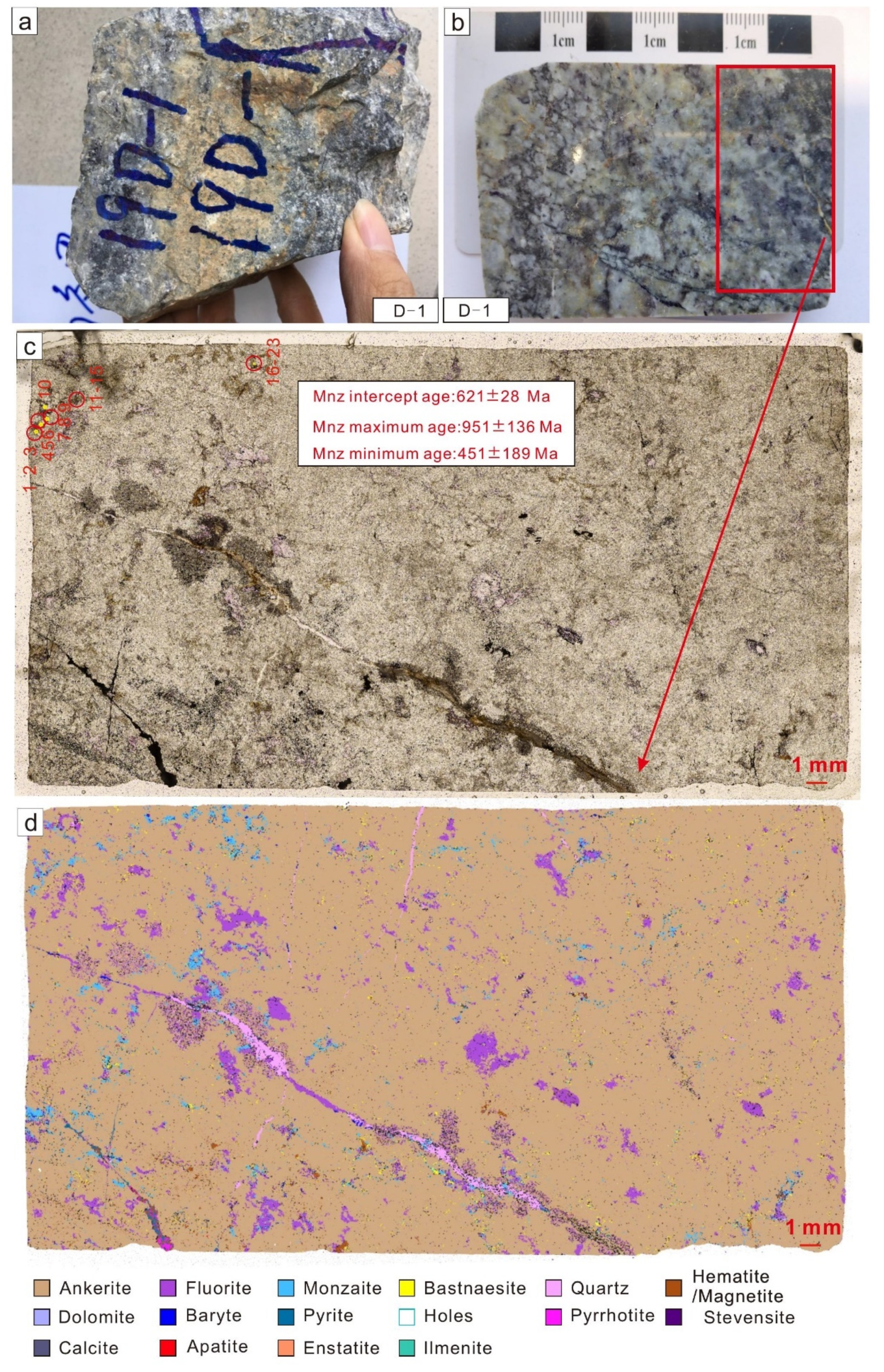


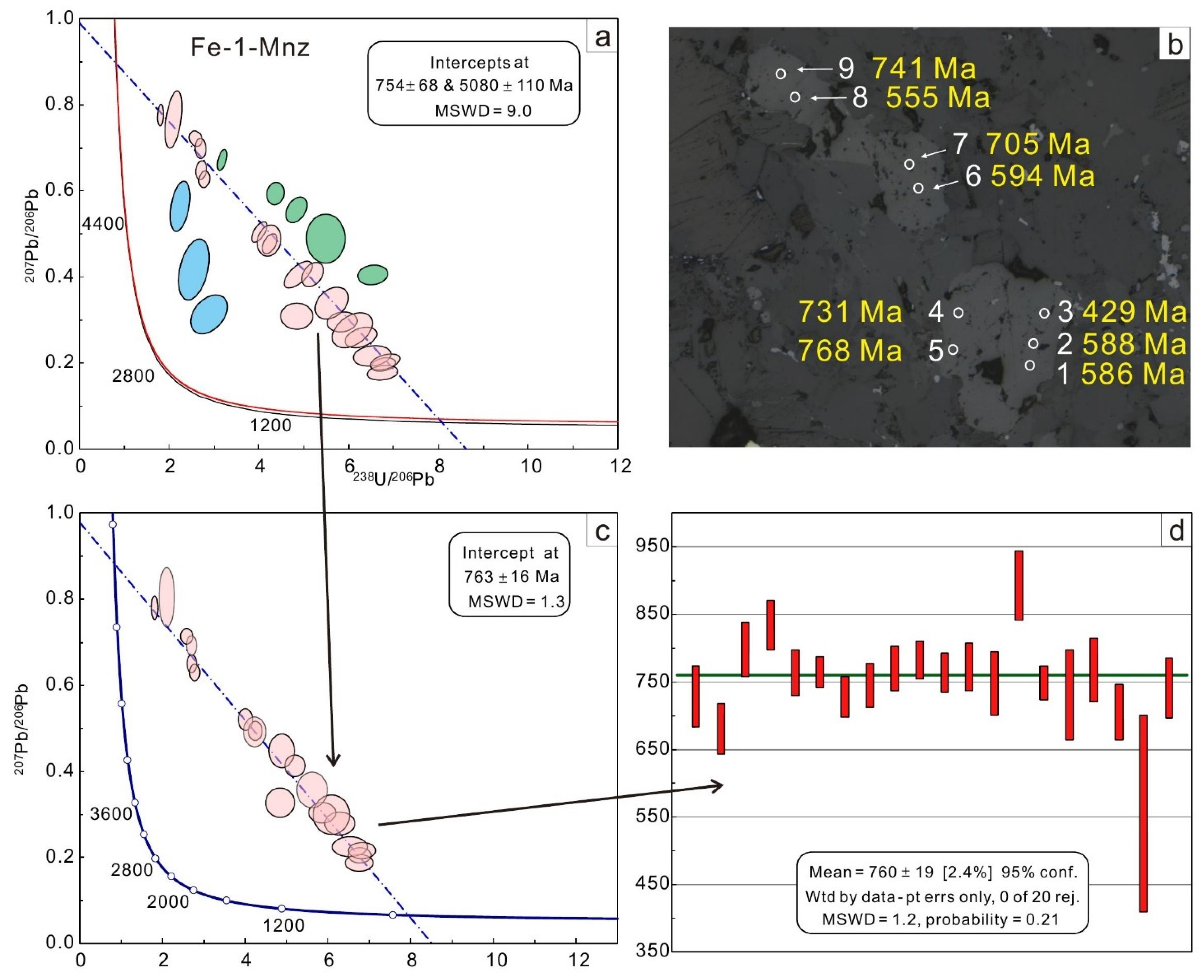
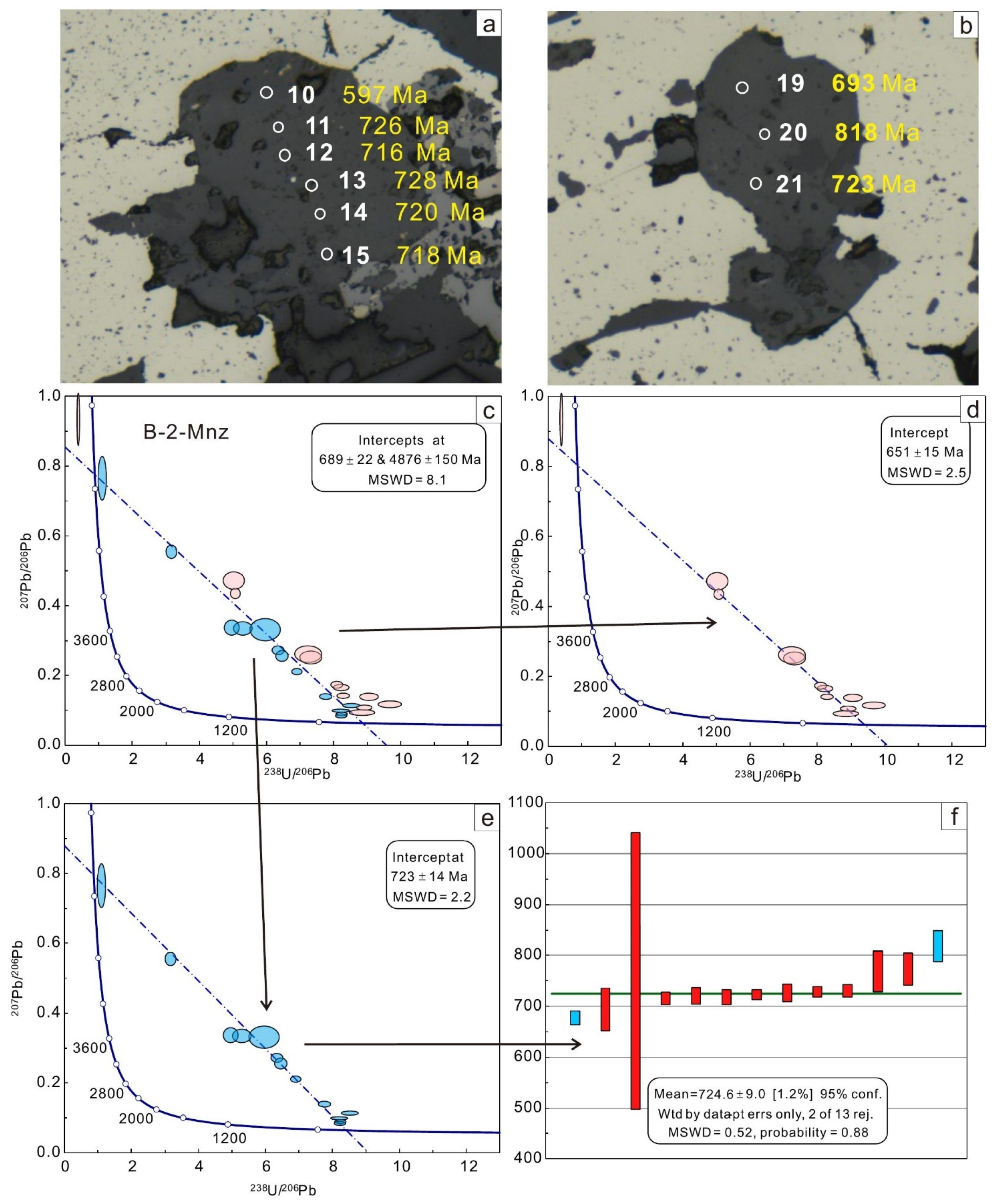
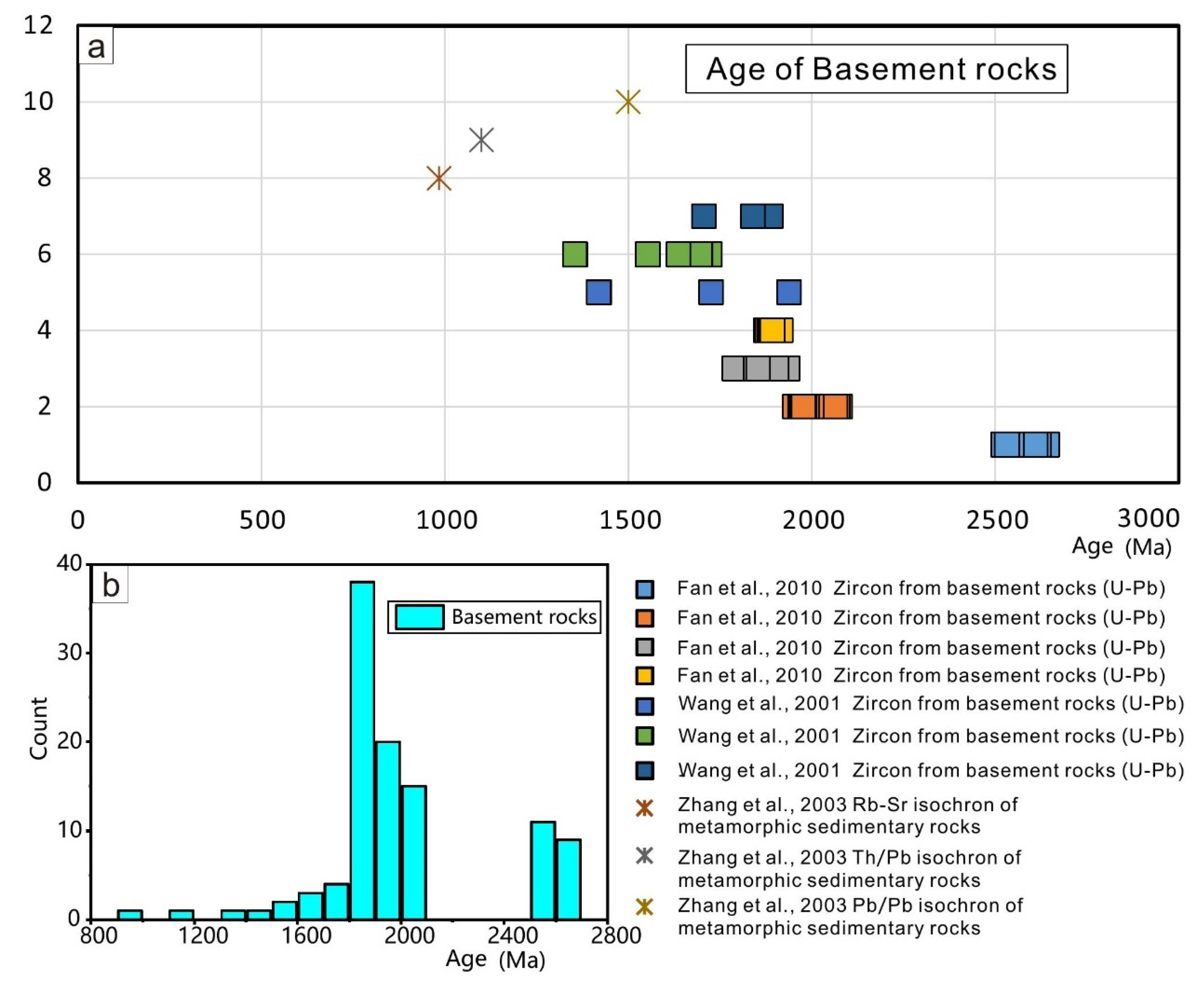
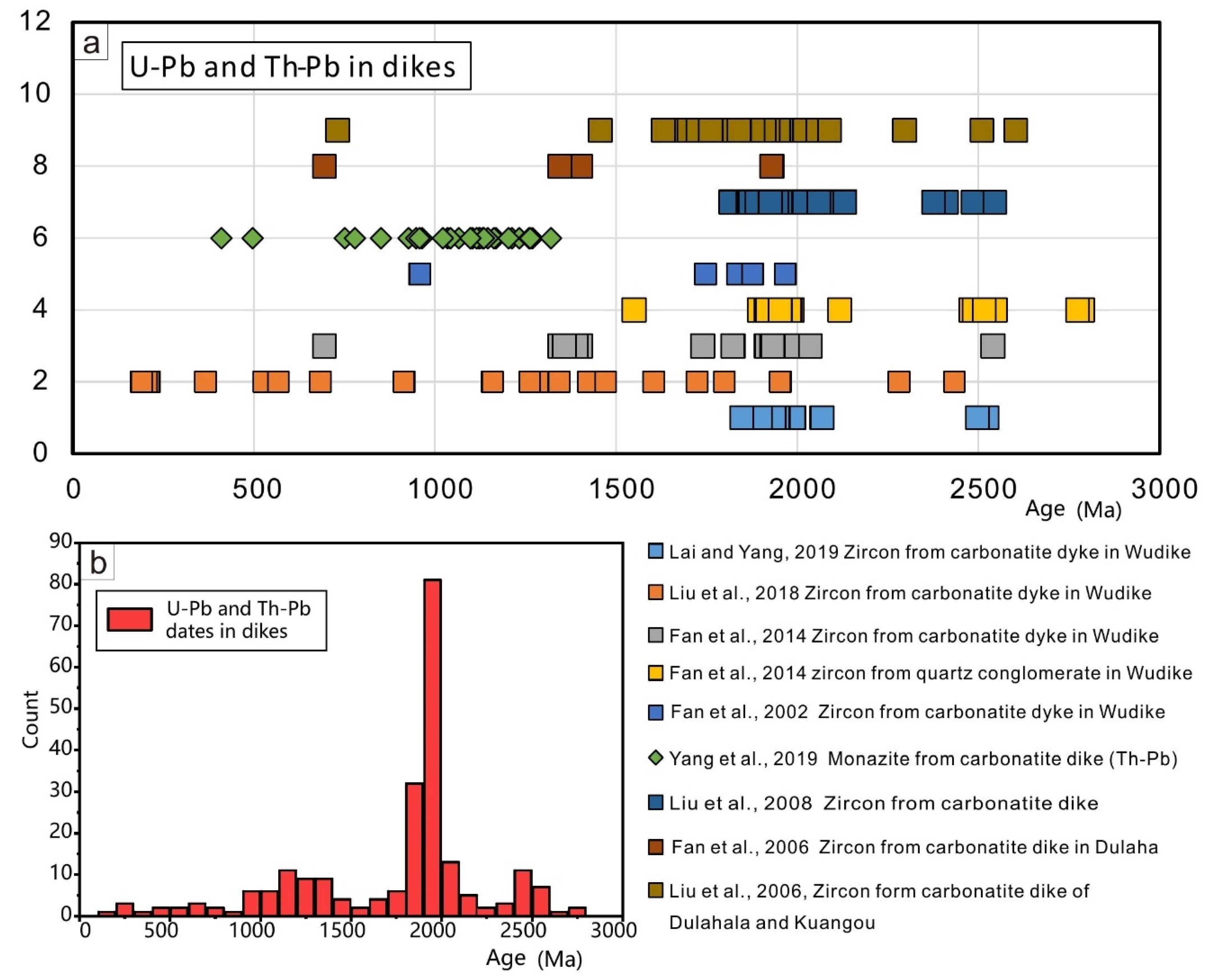



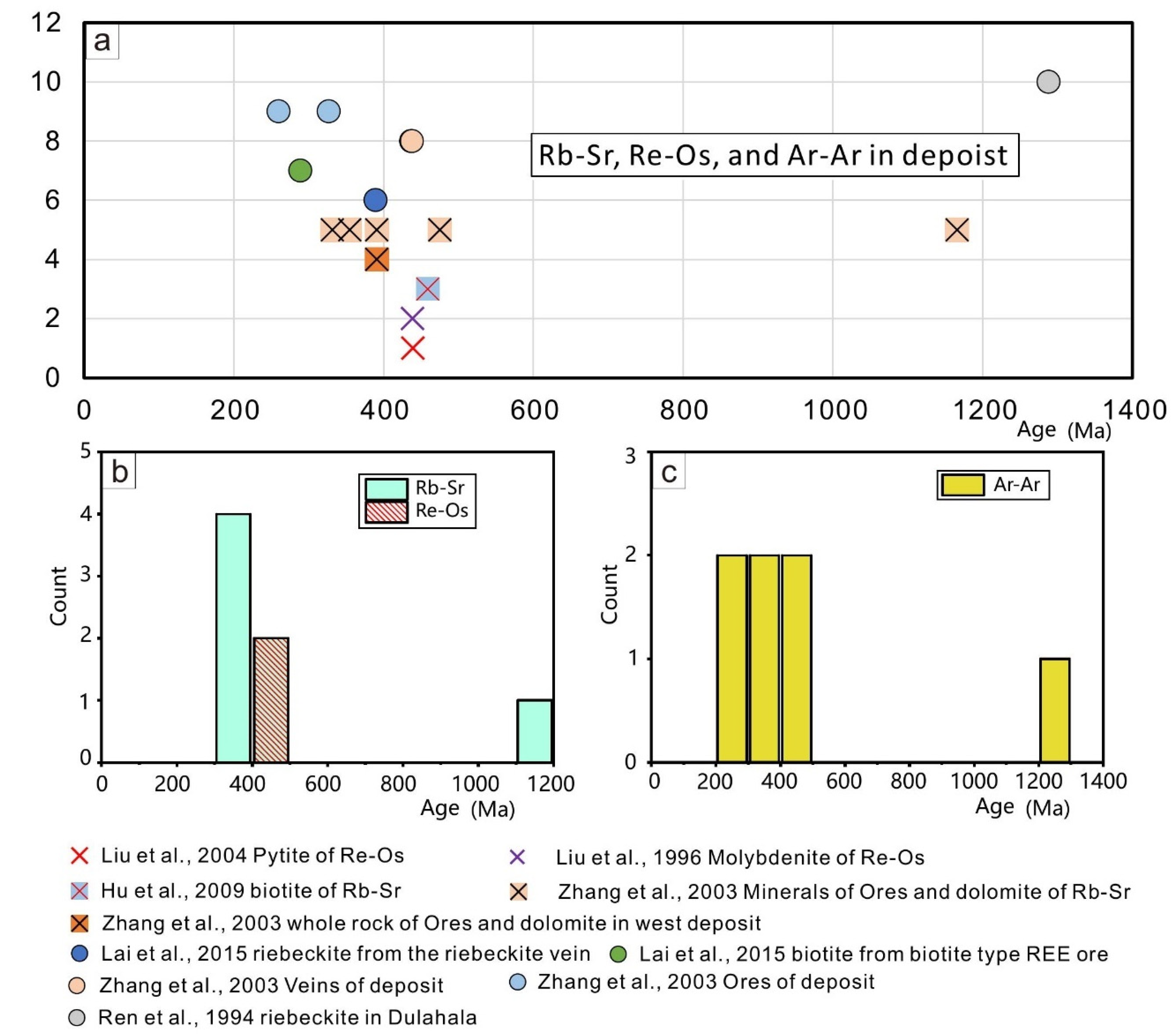

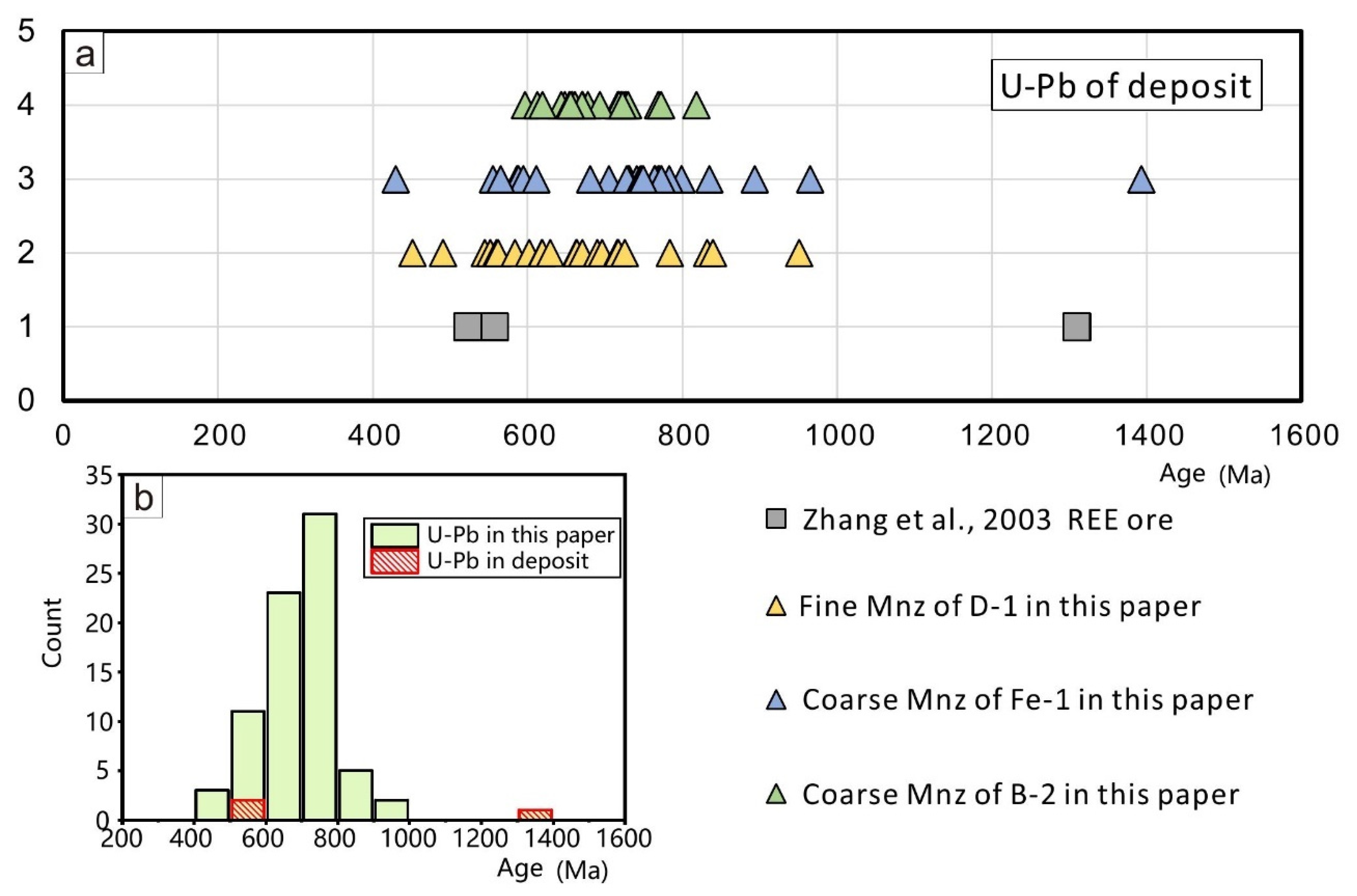
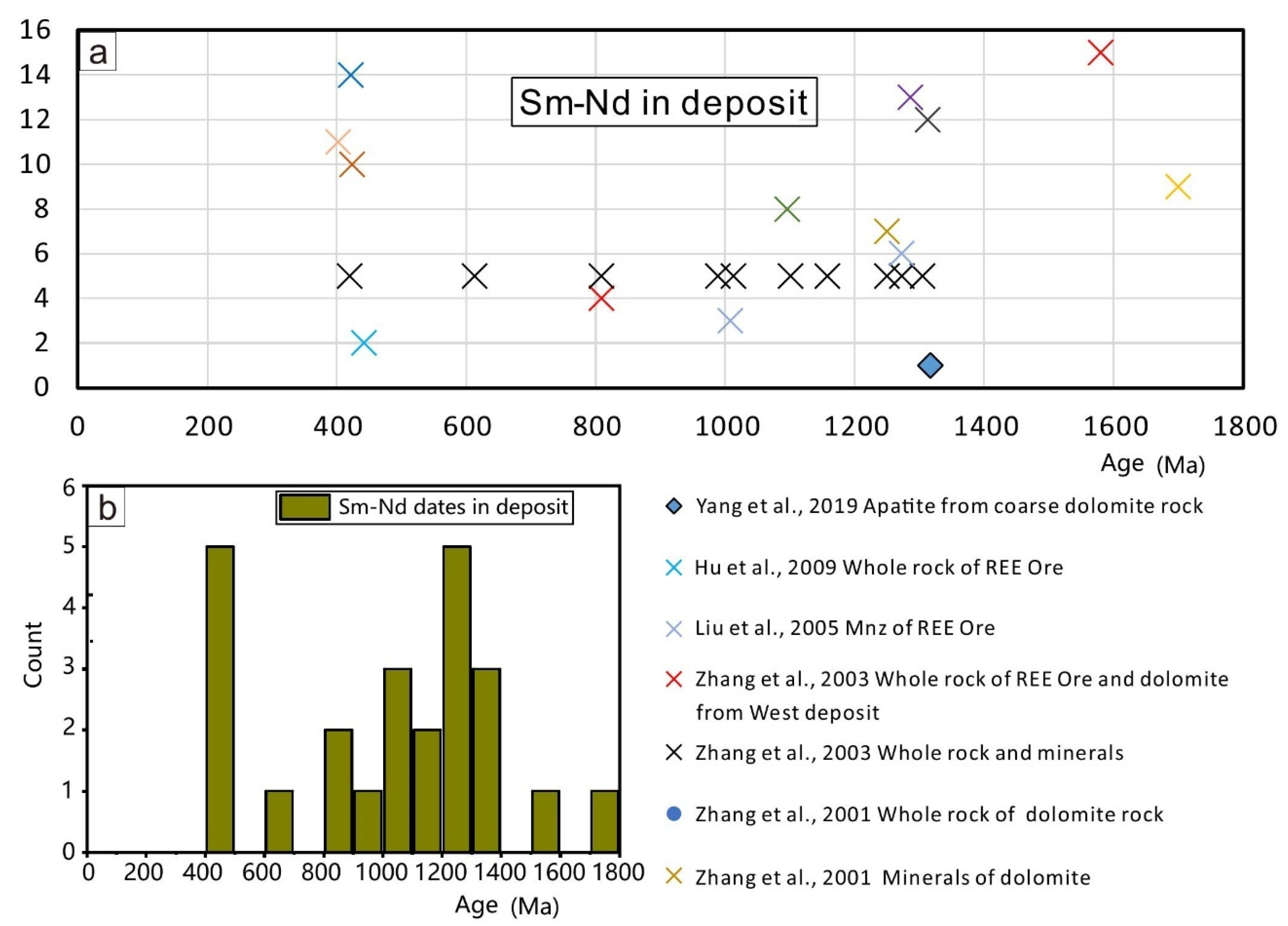
| Sample | 207Pb/206Pb | 207Pb/235U | 206Pb/238U | 207Pb/206Pb | 207Pb/235U | 206Pb/238U | Corrected 207Pb | |||||||
|---|---|---|---|---|---|---|---|---|---|---|---|---|---|---|
| Ratios | Error | Ratios | Error | Ratios | Error | Age (Ma) | Error | Age (Ma) | Error | Age (Ma) | Error | Age (Ma) | Error | |
| D-1-1 | 0.85288 | 0.02038 | 151.28601 | 10.43775 | 1.27279 | 0.07046 | 5012.71 | 33.89 | 5103.07 | 69.59 | 5292.56 | 199.84 | 451 | 189 |
| D-1-2 | 0.74446 | 0.02205 | 73.47275 | 4.59344 | 0.74074 | 0.04314 | 4819.02 | 42.38 | 4376.74 | 62.63 | 3573.33 | 159.76 | 839 | 124 |
| D-1-3 | 0.65630 | 0.03403 | 47.13776 | 3.06107 | 0.53915 | 0.02746 | 4637.87 | 74.84 | 3933.66 | 64.57 | 2779.87 | 114.99 | 951 | 136 |
| D-1-6 | 0.73768 | 0.03965 | 56.20797 | 3.87909 | 0.60257 | 0.03811 | 4805.92 | 76.95 | 4108.94 | 68.85 | 3040.17 | 153.28 | 716 | 174 |
| D-1-7 | 0.71520 | 0.04289 | 52.86402 | 5.33199 | 0.61839 | 0.05588 | 4761.56 | 86.05 | 4047.79 | 100.51 | 3103.50 | 222.58 | 832 | 199 |
| D-1-8 | 0.74562 | 0.03310 | 45.67565 | 2.42007 | 0.47810 | 0.02308 | 4821.25 | 63.51 | 3902.34 | 52.65 | 2519.00 | 100.66 | 545 | 116 |
| D-1-9 | 0.42370 | 0.01684 | 10.39226 | 0.46990 | 0.18046 | 0.00508 | 3995.39 | 59.44 | 2470.36 | 41.88 | 1069.47 | 27.74 | 629 | 28 |
| D-1-10 | 0.75448 | 0.02597 | 57.35004 | 2.67765 | 0.57737 | 0.02609 | 4838.13 | 49.21 | 4129.01 | 46.60 | 2938.01 | 106.61 | 618 | 110 |
| D-1-11 | 0.62007 | 0.01960 | 32.41145 | 1.74210 | 0.38467 | 0.01712 | 4555.74 | 45.82 | 3562.88 | 52.94 | 2098.07 | 79.71 | 784 | 63 |
| D-1-12 | 0.81813 | 0.02473 | 102.41723 | 5.41188 | 0.92146 | 0.04433 | 4953.63 | 42.99 | 4710.13 | 53.14 | 4210.06 | 148.71 | 559 | 165 |
| D-1-13 | 0.48692 | 0.01815 | 13.30536 | 0.68336 | 0.19886 | 0.00784 | 4202.08 | 55.07 | 2701.56 | 48.50 | 1169.20 | 42.13 | 602 | 35 |
| D-1-14 | 0.65925 | 0.03261 | 34.63900 | 2.34831 | 0.38060 | 0.01995 | 4644.34 | 71.39 | 3628.41 | 66.91 | 2079.06 | 93.15 | 671 | 94 |
| D-1-16 | 0.60240 | 0.02424 | 25.80982 | 1.18464 | 0.33011 | 0.01468 | 4513.81 | 58.46 | 3339.36 | 44.87 | 1838.94 | 71.14 | 717 | 64 |
| D-1-17 | 0.58013 | 0.03145 | 23.71232 | 1.42108 | 0.31098 | 0.01365 | 4459.00 | 78.98 | 3256.64 | 58.39 | 1745.51 | 67.12 | 726 | 76 |
| D-1-18 | 0.50764 | 0.02469 | 14.15692 | 0.76965 | 0.21527 | 0.00993 | 4263.54 | 71.61 | 2760.28 | 51.56 | 1256.85 | 52.68 | 619 | 47 |
| D-1-19 | 0.78729 | 0.02575 | 63.48637 | 3.25911 | 0.58664 | 0.02519 | 4898.91 | 46.63 | 4230.55 | 51.32 | 2975.80 | 102.35 | 490 | 110 |
| D-1-20 | 0.55094 | 0.03077 | 20.04379 | 0.86797 | 0.28115 | 0.01090 | 4383.66 | 81.67 | 3093.47 | 41.88 | 1597.15 | 54.85 | 716 | 67 |
| D-1-21 | 0.59621 | 0.02914 | 25.13859 | 1.58716 | 0.31361 | 0.01450 | 4498.78 | 71.04 | 3313.61 | 61.66 | 1758.45 | 71.17 | 696 | 72 |
| D-1-23 | 0.31827 | 0.02228 | 6.51448 | 0.37749 | 0.15619 | 0.00563 | 3561.50 | 107.71 | 2047.86 | 51.01 | 935.55 | 31.37 | 664 | 34 |
| D-1-22 | 0.50581 | 0.02334 | 15.86042 | 0.90903 | 0.23966 | 0.00969 | 4258.23 | 67.94 | 2868.43 | 54.74 | 1384.93 | 50.41 | 690 | 48 |
| D-1-24 | 0.53582 | 0.02136 | 15.09406 | 0.76710 | 0.20619 | 0.00789 | 4342.90 | 58.43 | 2821.19 | 48.40 | 1208.47 | 42.17 | 552 | 38 |
| D-1-25 | 0.40400 | 0.01601 | 8.50137 | 0.34666 | 0.15424 | 0.00351 | 3924.04 | 59.53 | 2286.07 | 37.05 | 924.70 | 19.60 | 562 | 22 |
| D-1-26 | 0.37966 | 0.01205 | 8.05161 | 0.31504 | 0.15294 | 0.00372 | 3830.40 | 47.95 | 2236.83 | 35.34 | 917.44 | 20.77 | 584 | 19 |
| D-1-27 | 0.51094 | 0.02130 | 15.62586 | 0.77745 | 0.23295 | 0.00829 | 4273.08 | 61.34 | 2854.20 | 47.48 | 1349.94 | 43.35 | 663 | 42 |
| Sample | 207Pb/206Pb | 207Pb/235U | 206Pb/238U | 207Pb/206Pb | 207Pb/235U | 206Pb/238U | Corrected 207Pb | |||||||
|---|---|---|---|---|---|---|---|---|---|---|---|---|---|---|
| Ratios | Error | Ratios | Error | Ratios | Error | Age (Ma) | Error | Age (Ma) | Error | Age (Ma) | Error | Age (Ma) | Error | |
| Fe-1-1 | 0.59700 | 0.01559 | 18.74333 | 0.72809 | 0.22913 | 0.00676 | 4880.51 | 76.61 | 3943.49 | 48.83 | 2475.79 | 106.60 | 586 | 29 |
| Fe-1-2 | 0.40577 | 0.01559 | 8.48333 | 0.40837 | 0.15323 | 0.00519 | 4582.06 | 28.50 | 3472.41 | 30.81 | 1892.17 | 42.55 | 588 | 25 |
| Fe-1-3 | 0.40662 | 0.02077 | 6.03316 | 0.35152 | 0.11113 | 0.00502 | 2847.19 | 92.28 | 1604.87 | 40.55 | 859.92 | 18.20 | 429 | 24 |
| Fe-1-4 | 0.77989 | 0.01791 | 59.06623 | 1.93758 | 0.55223 | 0.01495 | 2975.90 | 112.06 | 1707.59 | 63.84 | 902.13 | 34.29 | 731 | 67 |
| Fe-1-5 | 0.48992 | 0.02331 | 15.76650 | 0.95309 | 0.23670 | 0.00986 | 2676.37 | 115.06 | 1509.43 | 52.77 | 864.71 | 25.56 | 769 | 47 |
| Fe-1-6 | 0.49203 | 0.03850 | 12.23397 | 1.14521 | 0.18235 | 0.00946 | 4050.90 | 205.25 | 2639.43 | 95.46 | 1344.44 | 116.95 | 594 | 55 |
| Fe-1-7 | 0.69309 | 0.01506 | 35.64064 | 1.33451 | 0.37022 | 0.01098 | 3495.06 | 142.21 | 2239.48 | 90.34 | 1159.05 | 40.22 | 705 | 41 |
| Fe-1-8 | 0.80495 | 0.04617 | 50.20192 | 3.05863 | 0.47543 | 0.02700 | 3888.22 | 633.11 | 3043.27 | 107.94 | 1965.76 | 176.23 | 555 | 147 |
| Fe-1-9 | 0.35359 | 0.02748 | 8.25545 | 0.57974 | 0.17825 | 0.00769 | 3745.91 | 136.90 | 2782.65 | 99.43 | 1889.16 | 151.40 | 741 | 44 |
| Fe-1-10 | 0.65054 | 0.05886 | 34.63041 | 2.58078 | 0.44640 | 0.02957 | 3890.56 | 80.23 | 1936.34 | 49.12 | 664.61 | 28.96 | 965 | 177 |
| Fe-1-11 | 0.44474 | 0.02639 | 11.41670 | 0.45671 | 0.20529 | 0.00860 | 4865.96 | 33.47 | 4106.13 | 30.08 | 2752.26 | 58.88 | 730 | 46 |
| Fe-1-12 | 0.71436 | 0.01135 | 38.40415 | 1.66262 | 0.38593 | 0.01433 | 4713.07 | 37.20 | 3436.33 | 23.49 | 1721.49 | 35.74 | 681 | 37 |
| Fe-1-13 | 0.65107 | 0.01360 | 32.84459 | 1.10410 | 0.36743 | 0.01083 | 4751.79 | 22.66 | 3675.41 | 40.81 | 2014.93 | 61.17 | 799 | 39 |
| Fe-1-14 | 0.62896 | 0.01244 | 31.08316 | 1.00418 | 0.36036 | 0.01017 | 4441.26 | 49.50 | 2835.57 | 34.27 | 1174.62 | 33.34 | 835 | 37 |
| Fe-1-15 | 0.51912 | 0.01689 | 17.34889 | 0.44353 | 0.25025 | 0.00712 | 4722.35 | 30.93 | 3618.00 | 36.54 | 1957.39 | 48.45 | 764 | 34 |
| Fe-1-16 | 0.20001 | 0.01198 | 3.92425 | 0.20944 | 0.14787 | 0.00396 | 4444.17 | 41.06 | 2926.70 | 34.43 | 1260.27 | 36.90 | 765 | 23 |
| Fe-1-17 | 0.57160 | 0.02012 | 15.82556 | 0.59317 | 0.20697 | 0.00670 | 3926.30 | 55.47 | 2315.83 | 53.59 | 942.40 | 34.36 | 565 | 32 |
| Fe-1-18 | 0.41006 | 0.01696 | 10.68892 | 0.49094 | 0.19242 | 0.00599 | 4603.25 | 42.27 | 3432.70 | 28.28 | 1816.76 | 48.61 | 728 | 30 |
| Fe-1-19 | 0.27562 | 0.01783 | 5.60242 | 0.32951 | 0.15946 | 0.00599 | 4243.14 | 115.93 | 2723.22 | 91.67 | 1235.53 | 86.27 | 746 | 33 |
| Fe-1-20 | 0.29961 | 0.01603 | 6.88224 | 0.40906 | 0.17086 | 0.00634 | 4322.74 | 47.07 | 2932.21 | 24.50 | 1388.81 | 34.84 | 771 | 33 |
| Fe-1-21 | 0.18286 | 0.01271 | 3.53845 | 0.24038 | 0.14822 | 0.00493 | 4086.85 | 88.06 | 2526.31 | 36.93 | 1152.77 | 43.10 | 783 | 28 |
| Fe-1-22 | 0.49235 | 0.01494 | 15.47645 | 0.45993 | 0.23642 | 0.00605 | 4017.99 | 50.82 | 2539.35 | 34.83 | 1128.95 | 27.86 | 764 | 30 |
| Fe-1-23 | 0.22036 | 0.01533 | 4.49083 | 0.35139 | 0.15343 | 0.00651 | 4216.31 | 44.79 | 2815.43 | 26.63 | 1331.92 | 28.26 | 773 | 35 |
| Fe-1-24 | 0.29517 | 0.03028 | 6.18301 | 0.55655 | 0.16453 | 0.00790 | 4196.54 | 70.09 | 2836.48 | 55.81 | 1347.57 | 48.68 | 748 | 47 |
| Fe-1-25 | 0.68815 | 0.01699 | 29.14441 | 0.67347 | 0.31413 | 0.00713 | 4646.85 | 120.71 | 3623.78 | 75.67 | 2304.34 | 127.46 | 611 | 37 |
| Fe-1-26 | 0.32395 | 0.02281 | 8.70527 | 0.72037 | 0.20659 | 0.00999 | 3340.86 | 101.19 | 1885.52 | 49.64 | 920.77 | 30.77 | 894 | 51 |
| Fe-1-27 | 0.35937 | 0.03238 | 14.76847 | 1.55106 | 0.34666 | 0.03219 | 3690.20 | 113.48 | 2224.68 | 60.98 | 1042.41 | 41.97 | 1393 | 143 |
| Fe-1-28 | 0.29364 | 0.20272 | 22.49282 | 2.60820 | 0.39374 | 0.03509 | 3430.82 | 159.33 | 1975.98 | 76.24 | 962.93 | 38.93 | 1737 | 523 |
| Fe-1-30 | 0.21166 | 0.01217 | 4.02332 | 0.23191 | 0.14694 | 0.00468 | 2917.10 | 93.06 | 1629.72 | 46.42 | 875.09 | 25.37 | 749 | 26 |
| Sample | 207Pb/206Pb | 207Pb/235U | 206Pb/238U | 207Pb/206Pb | 207Pb/235U | 206Pb/238U | Corrected 207Pb | |||||||
|---|---|---|---|---|---|---|---|---|---|---|---|---|---|---|
| Ratios | Error | Ratios | Error | Ratios | Error | Age (Ma) | Error | Age (Ma) | Error | Age (Ma) | Error | Age (Ma) | Error | |
| B-2-2 | 0.76534 | 0.04117 | 89.58931 | 5.63648 | 0.90126 | 0.06512 | 4858.56 | 76.84 | 4575.66 | 63.18 | 4141.93 | 220.80 | 769 | 273 |
| B-2-3 | 0.24663 | 0.01246 | 4.62578 | 0.27175 | 0.13669 | 0.00398 | 3163.26 | 80.14 | 1753.93 | 49.05 | 825.92 | 22.58 | 648 | 22 |
| B-2-4 | 0.25808 | 0.01587 | 4.96290 | 0.38695 | 0.13823 | 0.00495 | 3235.04 | 96.94 | 1813.02 | 65.89 | 834.66 | 28.01 | 644 | 27 |
| B-2-5 | 0.13698 | 0.00444 | 2.26374 | 0.07494 | 0.12077 | 0.00172 | 2189.41 | 56.37 | 1201.07 | 23.31 | 735.01 | 9.88 | 671 | 10 |
| B-2-6 | 0.10245 | 0.00497 | 1.59006 | 0.08393 | 0.11236 | 0.00191 | 1669.02 | 89.70 | 966.32 | 32.90 | 686.46 | 11.07 | 654 | 12 |
| B-2-7 | 0.16856 | 0.00625 | 2.87617 | 0.11949 | 0.12360 | 0.00177 | 2543.41 | 62.16 | 1375.69 | 31.30 | 751.26 | 10.16 | 658 | 11 |
| B-2-8 | 0.43299 | 0.00937 | 11.89832 | 0.36891 | 0.19774 | 0.00381 | 4027.80 | 32.30 | 2596.43 | 29.04 | 1163.18 | 20.51 | 661 | 18 |
| B-2-9 | 0.10831 | 0.00421 | 1.74606 | 0.07714 | 0.11747 | 0.00233 | 1771.20 | 71.00 | 1025.71 | 28.53 | 715.97 | 13.46 | 678 | 14 |
| B-2-10 | 0.11188 | 0.00687 | 1.61725 | 0.11641 | 0.10354 | 0.00244 | 1830.10 | 111.29 | 976.92 | 45.16 | 635.13 | 14.22 | 597 | 15 |
| B-2-11 | 0.25206 | 0.00997 | 5.56964 | 0.27917 | 0.15492 | 0.00289 | 3197.75 | 62.59 | 1911.42 | 43.15 | 928.47 | 16.14 | 726 | 17 |
| B-2-12 | 0.13511 | 0.00528 | 2.39408 | 0.09745 | 0.12886 | 0.00207 | 2165.47 | 68.09 | 1240.83 | 29.15 | 781.35 | 11.84 | 716 | 12 |
| B-2-13 | 0.07791 | 0.00383 | 1.29121 | 0.05956 | 0.12162 | 0.00163 | 1144.46 | 97.74 | 841.83 | 26.39 | 739.87 | 9.38 | 728 | 10 |
| B-2-14 | 0.26798 | 0.00843 | 5.86563 | 0.23032 | 0.15777 | 0.00285 | 3294.26 | 49.39 | 1956.16 | 34.06 | 944.36 | 15.90 | 720 | 16 |
| B-2-15 | 0.09276 | 0.00319 | 1.56069 | 0.05965 | 0.12222 | 0.00252 | 1483.06 | 65.08 | 954.74 | 23.65 | 743.30 | 14.49 | 718 | 15 |
| B-2-16 | 0.20569 | 0.00630 | 4.13203 | 0.15643 | 0.14509 | 0.00211 | 2871.92 | 49.81 | 1660.66 | 30.95 | 873.39 | 11.90 | 730 | 12 |
| B-2-17 | 0.47021 | 0.01679 | 12.98280 | 0.76921 | 0.19941 | 0.00822 | 4150.42 | 52.89 | 2678.41 | 55.86 | 1172.16 | 44.20 | 613 | 35 |
| B-2-18 | 0.13306 | 0.00684 | 2.03875 | 0.11279 | 0.11060 | 0.00222 | 2138.71 | 89.83 | 1128.54 | 37.69 | 676.23 | 12.89 | 619 | 13 |
| B-2-19 | 0.32755 | 0.02100 | 7.92754 | 0.68923 | 0.16800 | 0.00839 | 3605.67 | 98.35 | 2222.82 | 78.39 | 1001.10 | 46.33 | 693 | 42 |
| B-2-20 | 0.33448 | 0.01423 | 9.79665 | 0.54656 | 0.20182 | 0.00577 | 3637.75 | 65.12 | 2415.84 | 51.40 | 1185.08 | 30.96 | 818 | 31 |
| B-2-21 | 0.08284 | 0.00323 | 1.38301 | 0.05593 | 0.12151 | 0.00162 | 1265.55 | 76.03 | 881.72 | 23.83 | 739.23 | 9.32 | 723 | 10 |
| B-2-22 | 0.08839 | 0.00562 | 1.36849 | 0.08501 | 0.11326 | 0.00314 | 1391.03 | 122.09 | 875.52 | 36.45 | 691.67 | 18.18 | 670 | 19 |
| B-2-23 | 0.55380 | 0.01299 | 25.19045 | 1.21740 | 0.31644 | 0.01130 | 4391.23 | 34.29 | 3315.63 | 47.20 | 1772.30 | 55.36 | 769 | 40 |
| B-2-24 | 0.16031 | 0.00581 | 2.73478 | 0.13512 | 0.12173 | 0.00230 | 2458.90 | 61.22 | 1337.96 | 36.74 | 740.53 | 13.19 | 655 | 13 |
| B-2-25 | 0.33153 | 0.01292 | 8.41392 | 0.36509 | 0.18920 | 0.00651 | 3624.18 | 59.69 | 2276.68 | 39.38 | 1117.06 | 35.28 | 773 | 31 |
Publisher’s Note: MDPI stays neutral with regard to jurisdictional claims in published maps and institutional affiliations. |
© 2022 by the authors. Licensee MDPI, Basel, Switzerland. This article is an open access article distributed under the terms and conditions of the Creative Commons Attribution (CC BY) license (https://creativecommons.org/licenses/by/4.0/).
Share and Cite
Tian, P.; Yang, X.; Xiao, Y.; Yuan, W.; He, Z. In Situ Monazite U–Pb Ages in Thin Sections from the Giant Bayan Obo Fe–REE–Nb Deposit, Inner Mongolia: Implications for Formation Sequences. Minerals 2022, 12, 1237. https://doi.org/10.3390/min12101237
Tian P, Yang X, Xiao Y, Yuan W, He Z. In Situ Monazite U–Pb Ages in Thin Sections from the Giant Bayan Obo Fe–REE–Nb Deposit, Inner Mongolia: Implications for Formation Sequences. Minerals. 2022; 12(10):1237. https://doi.org/10.3390/min12101237
Chicago/Turabian StyleTian, Pengfei, Xiaoyong Yang, Yulun Xiao, Wanming Yuan, and Zifei He. 2022. "In Situ Monazite U–Pb Ages in Thin Sections from the Giant Bayan Obo Fe–REE–Nb Deposit, Inner Mongolia: Implications for Formation Sequences" Minerals 12, no. 10: 1237. https://doi.org/10.3390/min12101237





